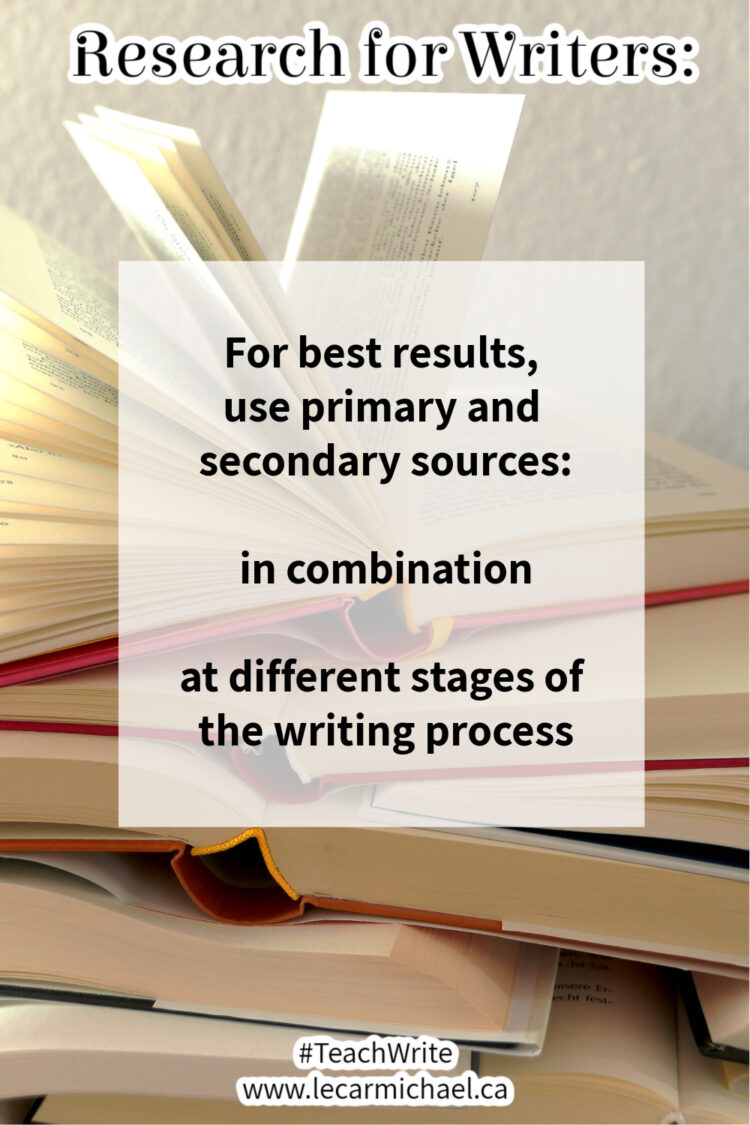Welcome to Teach Write! This column draws on my 20 years’ experience teaching writing to kids, university students, and adult learners. It includes ideas and exercises that teachers and students can use in the classroom, and creative writers can use to level up their process.
It’s September, which means school, which means writing assignments, which (often) means research. Research is a key part of the preparation phase for many writing assignments, not to mention for creative writers working on nonfiction projects or (usually) novels. Research is also one of my favourite parts of writing. I love learning new things – the weirder or more obscure the better!
What can I say, I’m nerdy that way. #ownit
 We are going to be devoting many Teach Write columns to the intricacies of research for student and professional writers. Today, we are starting with the fundamentals: the difference between primary and secondary sources. Students need to understand this distinction, because teachers (particularly in college or university) will often require a particular type and number of sources in their assignments. Creative writers need to understand it, too, and not just because editors have a favourite (hint: it’s the first kind).
We are going to be devoting many Teach Write columns to the intricacies of research for student and professional writers. Today, we are starting with the fundamentals: the difference between primary and secondary sources. Students need to understand this distinction, because teachers (particularly in college or university) will often require a particular type and number of sources in their assignments. Creative writers need to understand it, too, and not just because editors have a favourite (hint: it’s the first kind).
Each type of source has advantages and disadvantages, and both have value. Let’s dig in!
Primary Sources
Primary sources are original, first hand sources of information. This is information held or presented by the people who created or discovered the knowledge in the first place. In other words, it’s your personal experience or someone else’s.
For research purposes, there are a couple major categories of primary sources:
- peer-reviewed academic journal articles, where researchers publish first-hand accounts of their research
- interviews with living experts, where expert can mean anything from a scientist to a carpenter to a pet groomer, depending on the topic and context
- archival material like maps, diaries, letters, photographs and other materials produced by experts who are no longer living
Advantages of primary sources:
- there is nothing between you and the original source of the information, increasing the chance that the facts you collect are accurate
- they are full of odd, interesting, unique, and specific details that you won’t find anywhere else
Disadvantages of primary sources:
- they are focused and specific and assume a certain level of background knowledge, meaning they are usually a terrible place to begin research on a new topic
- journal articles are written for other experts, and tend to be pretty heavy going for the casual reader
- they can be hard to access
- academic journal articles are easiest to find using specialized databases, which most public libraries don’t subscribe to. And many journals are behind paywalls, so unless you have access to a university library, using these sources can be very expensive
- reaching out to living experts can be very intimidating (more on this in a later column), and they may not respond before your deadline
In general, however, the advantages of using primary sources outweigh the disadvantages, so include them in your research whenever you can. Just don’t START there. Instead, I recommend starting with…
Secondary Sources
Secondary sources are – shocker! – second-hand information. This is information that has been collected, compiled, filtered, synthesized, or simplified from primary sources.
Categories of secondary sources include:
- textbooks
- popular nonfiction books for kids or adults
- newspapers and magazines
- documentaries
- most of the internet
Advantages of secondary sources:
- with the exception of textbooks, they are relatively easy to access online or through public libraries
- they’re written for general audiences, like students (textbooks) or the general public (everything else), meaning they are usually easier to understand. This is especially helpful if you’re researching a brand new topic and need to get a handle on vocabulary or major concepts in the field
- they often contain interviews with experts, providing names of people you can contact for more information
Disadvantages of secondary sources:
- someone else stands between you and the original information, so you have to trust that
- the author understood their own research and is explaining it correctly
- the author has not introduced a bias or made conclusions that the original sources might not support
- in the case of kids’ book, the author hasn’t simplified to the point of introducing inaccuracies
- the information may be out of date – particularly in the case of books and textbooks, which can take several years to research, write, and publish
In short, secondary sources are a great place to begin research, but they have to be used cautiously and, ideally, in combination with primary sources. Personally, I like to get the basics from secondary sources and then use primary sources for confirmation, and for fresh, interesting details that haven’t already been reprinted in a million secondary sources. 😉
Next time, we’re going to take a closer look at how to access the gold standard of primary sources – peer-reviewed journal articles. Until then, share your research tips and tricks in the comments!
Hey, did you know I teach writing workshops? It’s true – I work with adult writers, teachers, and students of all ages. Contact me to learn more.